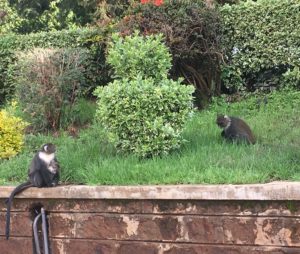Pediatrics
December 8th, 2019 by Elaina Truax Russo
It seemed like each day in the pediatric clinic last week had a theme. Day 1, we saw a lot of congenital limb abnormalities and developmental delays (delayed walking, talking, etc). We referred many of them to physiotherapy and some were also referred to the AIC-CURE international hospital which is an orthopedic pediatric teaching hospital located right beside Kijabe Hospital. This is a fantastic resource for people in the community. At Cure, they are able to perform surgeries for club feet and other orthopedic conditions. Their website is really interesting and we hope we get a chance to go into the hospital before we leave.
Day 2 seemed to bring in a lot of children that we referred to the outpatient pediatric surgery clinic which happens on Wednesdays. A lot of hernias and other surgical things.
Day 3 brought some sick kiddos. One child was hypoxic (low oxygen) in the clinic to the low 80s. We immediately took this little one to casualty (the emergency room) and hooked him up to oxygen. He ultimately got admitted and treated for pneumonia.
At the end of the day, a very jaundiced baby came in. Jaundice starts at the top of the head and works its way down on the body. This baby was jaundiced all the way to the feet! He was starting to look like a highlighter, which is never good. Unfortunately, we had received word earlier in the day that one of the machines in the lab was broken and only specific labs could be run that day. Therefore we were unable to get a bilirubin level on the baby to see what treatment he would need. The family was advised to drive to Nairobi for lab work and treatment.
Day 4 had some heartbreaking moments. A baby came in with craniosynostosis (cranial sutures close too early, causing skull abnormality). The parents traveled a long way via public transportation (at least 6 hours according to a direct route on google maps, but likely much longer with public transportation). The parents were told by a pediatrician in their community that the baby needed to see a neurosurgeon and the dad said he “googled” it and found Kijabe’s website. Unfortunately, the neurosurgeon at Kijabe left a few months ago so the hospital currently does not have one. The parents were advised of another missionary hospital they could go to which is actually closer to their home. The parents took this in stride (much better than an American parent would have taken it) and simply said “sawa sawa” (OK). It was actually very fascinating from a cultural standpoint. The Kenyan people are very soft-spoken, kind, and easy to laugh. Never once in the pediatric clinic did a parent yell or express anger over waiting to be seen or dissatisfaction with the medical recommendations. Much different than the US!
Later in the day a child came in with hearing difficulty. He was not doing well in school as a result. The patient had been treated with antibiotics for pneumonia as a baby, so the hearing loss was likely a result of a side effect of an antibiotic. We were able to send this child to ENT and he had a hearing test done. The plan will be for hearing aids when the family can afford it.
Day 5 was the day of jaundice. A lot of newborns came in for a checkup and we needed to check bilirubins. Thankfully the lab was working this day and we were able to get the labs that we needed. Two babies did have to be admitted for phototherapy. It is interesting that if the bilirubin level is very high, they have the ability to do IVIG and Exchange transfusion here. At home, we would send these babies to a pediatric hospital for care.
Overall, a very interesting week in pediatrics. Intermixed among these interesting cases were common colds and gastroenteritis. In regards to malnutrition, they do have a nutrition department here. They also supplement every child with vitamin A and a multivitamin. They give iron-folic acid to pregnant mothers. Most children are vaccinated. De-worming is done every 6 months from age 1-5 years.
A note to self and to others who may be coming to Kijabe in the future: I would definitely want to bring a tape measure next time to measure mid-upper arm circumference in children.

Monkeys at the hospital (mama and baby monkey on her belly)


Sorry, comments for this entry are closed at this time.